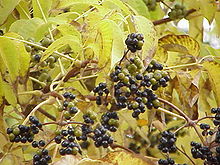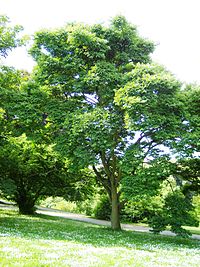- Phellodendron
-
Phellodendron 
Phellodendron amurense autumn leaves and fruit Scientific classification Kingdom: Plantae (unranked): Angiosperms (unranked): Eudicots (unranked): Rosids Order: Sapindales Family: Rutaceae Genus: Phellodendron Species About 10 species, including:
Phellodendron amurense
Phellodendron chinense
Phellodendron japonicum
Phellodendron lavallei
Phellodendron sachalinense
Phellodendron wilsoniiPhellodendron or Cork-tree, is a genus of deciduous trees in the family Rutaceae, native to east and northeast Asia. It has leathery, pinnate leaves and yellow, clumped flowers. The name refers to the thick and corky bark of some (but not all) species in the genus.
Cultivation and uses
As an ornamental plant, Phellodendron is a tree for all seasons. In spring it has yellow flowers, in summer it provides foliage and shade, in fall the leaves turn bright yellow and the textured bark and winding branches add interest in the winter. The female bears black drupes that attract birds and other wildlife through the late fall and winter.
The Cork-tree is resistant to drought and insects, and it can thrive in a variety of soils. It is hardy to zone 4 and it is easy to maintain, sometimes to the point of being invasive. One drawback is that the drupes fall and scatter, which may be undesirable on a formal lawn.
The bark in some species is thick, resembling that of the Cork Oak, but is not thick enough for commercial cork production. It has been used to produce a yellow dye.
One species, Amur cork tree, Phellodendron amurense (Chinese: 黄柏; pinyin: huáng bǎi; or 黄檗; pinyin: huáng bò; Russian: Бархат амурский "Barkhat Amurskiy", also бархатное дерево, пробковое дерево), is one of the 50 fundamental herbs used in traditional Chinese medicine. Recently, Phellodendron has also attracted the attention of the pharmaceutical community because of the phytochemicals it produces:
- Berberine has antibacterial and anti-fungal properties.
- Jactorrhizine (c.f. jatrorrhizine) may be anti-mutagenic.
- Phellodendrine has promise as an immune suppressant.
- Palmatine may be a vasodilator.
The phytochemical descriptions are included for informational purposes only and not for treatment purposes. The research at this stage is very preliminary. Traditionally, the bark is the principal part of the plant used medicinally, although oil from the fruit is also used. The species grows in Northern China, and in the Khabarovsk and Primorskiy regions of Russia.
Already identified as a significant forest invader in the mid-Atlantic region, Phellodendron amurense is an emerging species of concern in New England, and is identified as invasive or having invasive tendencies by state and private conservation authorities.[1] [2] [3] Because the fruit is plentiful and high in sugars, Amur cork-tree attracts birds and mammals which help disperse its seeds. Because of its phytochemical profile and because the seedlings grow thickly, Phellodendron can out-compete other species. By suppressing reproduction of native hardwoods, Amur cork-tree can come to dominate native forests under favorable conditions. As a relatively new species of concern, its invasion biology and response to control is not well understood.
See also
- Cork Oak
- Phellandrene
- Sān miáo wán
Categories:- Rutaceae
- Flora of Northeast Asia
- Trees of China
- Medicinal plants
- Invasive plant species in the United States
Wikimedia Foundation. 2010.

